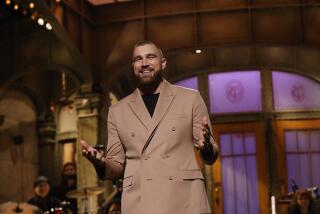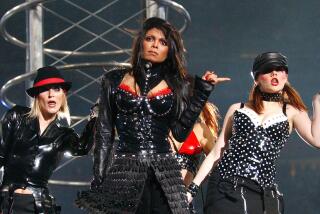Looking Back at Namath’s Prediction
- Share via
The cocky young man with the $400,000 arm, the 10-cent knees, the shaggy mane, the fur coat and the big mouth walked into the Fort Lauderdale, Fla., bar and made an announcement.
Pointing to a pair of Baltimore Colts players, Lou Michaels and Dan Sullivan, Joe Namath said, “We’re going to kick the (bleep) out of you, and I’m going to do it.”
And he did. But on that night a week before the 1969 Super Bowl, staged 20 years ago Thursday in Miami, hardly anyone except Namath thought much of the New York Jets’ chances against the Colts.
This was only the third Super Bowl matching the established National Football League against the upstart American Football League, and the NFL’s Green Bay Packers had won the first two overwhelmingly, by a combined score of 68-24 against the AFL’s Kansas City Chiefs and Oakland Raiders.
Who was Namath to think the Jets had a prayer against the mighty Colts? The Colts, after all, had scored 402 points and allowed only 144 in winning 13 of its 14 regular-season games.
Coach Don Shula’s Colts were a team that inspired superlatives. Ernie Stautner, a Dallas Cowboy assistant, said, “Baltimore has one of the greatest defenses of all time.”
George Allen, then the recently deposed Los Angeles Rams’ coach, said, “The early odds of 17 points sound about right to me.”
Yes, the odds. They were staggering, 16 1/2 points at kickoff. As Ordell Braase, who retired after that Super Bowl, says now, the NFL champion shouldn’t even be favored over the college all-stars by 16 1/2 points.
But people wanted to believe the point spread. A newspaper in North Carolina started a Ghoul Pool, with contestants drawing slips of paper numbered according to minutes in the game. The fan who held the number of the minute when Namath was put out of the game for good by the Colts’ pass rush was the winner.
“I’m not showing our people the Colt films until we get to Florida,” Jets Coach Weeb Ewbank said. “I’m afraid if they do see them, they won’t get off the airplane.”
But in that Florida saloon on the Sunday night before the Super Bowl, Namath was in fine form, and he getting under Michaels’ skin. Later in the week, before the Miami Touchdown Club, Namath would make his celebrated statement: “The Jets will win. I guarantee it.”
Namath kept baiting Michaels and Sullivan. He called the sore-armed John Unitas “an old man who’s over the hill.”
He called Earl Morrall, who replaced Unitas, “a has-been.” A career second-stringer, Morrall was 34, but he had thrown 26 touchdown passes for the Colts and was named the NFL Player of the Year.
Namath ignored that. He said there were four passers in the AFL who were better than Morrall. They were Oakland’s Daryle Lamonica, Kansas City’s John Hadl, Miami’s Bob Griese and, of course, himself.
Now, from the perspective of an additional 20 years of wisdom, Michaels wouldn’t have snapped at the bait.
“I told him I’d like to take him outside just for one minute,” Michaels said. “But he was no dummy.”
Namath was too smart to accept that invitation from a large defensive end. He declined, but he didn’t stop needling Michaels. There were no blows exchanged (“It would have been no contest,” snarled Michaels), only words.
“My mistake was that I should have overlooked the stupid jerk,” Michaels said. “If I had it to do over, I’d have walked out. But I kept thinking, ‘Who was he to keep talking this way?’ ”
Before an Orange Bowl crowd of 75,337, Namath led the Jets to a 7-0 advantage in the second quarter by directing an 80-yard scoring drive in 12 plays.
Ewbank sagely attacked the Colts’ aging defenders on the right side, where Braase, the 36-year-old defensive end, linebacker Don Shinnick and defensive back Lenny Lyles had 35 years of experience among them. Running back Matt Snell, who would wind up with 121 yards rushing, did most of the damage.
Just before halftime, the Colts ran a flea flicker play that would be discussed and debated for years.
Morrall handed off to halfback Tom Matte, who then tossed the ball back to Morrall. Jimmy Orr, the primary receiver, stood alone in one corner of the end zone, waving his arms, trying to get Morrall’s attention.
Orr recalls that the Colts used the play in the second game of the season against the Atlanta Falcons, and that it went for a touchdown. It is the sort of play a team uses only once or twice a season.
“When Earl handed to Matte, faking the sweep, the weak safety bit for the run and the cornerback also came up,” said Orr. “Looking at the film later, the closest Jets player to me was 37 yards away. I was thinking one thing: ‘Earl, throw it!’ ”
Willie Richardson was in the other corner of the end zone, also uncovered. Morrall elected to throw over the middle to fullback Jerry Hill, who was covered. The throw was behind him, and the Jets’ Jim Hudson intercepted.
The principals and their teammates have had plenty of time to replay it in their heads. Michaels, now living in Swoyersville, Pa., is the athletic director of the Luzerne County Correctional Center. Matte is executive vice president of sales and marketing for Storage Dynamics Inc., a high tech computer company. Braase is district manager of Penske Truck Leasing in Baltimore. Morrall owns the Arrowhead Country Club in Fort Lauderdale, and Orr has been back in Baltimore since October “to wait for the team to come back.” Mysteriously, he doesn’t say what he’s doing, only that “I just came back, like I do from time to time.”
They all have distinct thoughts about the flea flicker play.
“Earl was blinded by all the shirts in the stands,” Michaels said. “He flat out didn’t see Orr.”
“The stands came right down to the field,” Braase said, “and Orr isn’t too tall.”
“I was being chased and my throw to Earl was a little high,” Matte said. “I’ve always felt that the high school band in blue and white uniforms behind the end zone waiting to play at halftime was a real factor. No wonder Earl never saw Orr. He rushed it a bit, threw behind Hill and the Jets intercepted.”
Morrall acknowledges that everything his former teammates said was true, but he didn’t seize on that as an excuse.
“It was just one of those things,” Morrall said. “It’s true what Matte says about the uniforms, but that’s no excuse. The primary receiver was Orr. I didn’t see him, but I did see the fullback coming open in the center of the field. I hung it out there too much.”
In the fourth quarter, the Jets increased their lead to 16-0. Shula, desperate, sent in Unitas, who had missed most of the season with a sore elbow. Unitas directed the Colts to their only touchdown, but time ran out on him, leaving the final at 16-7.
Ewbank’s Jets made big plays and few mistakes. Namath picked the Colts’ proud secondary to pieces, Snell ran for his 121 yards and the Jets intercepted four passes.
“I’ve been to a lot of wakes,” Colts handyman Alex Hawkins said in the locker room, which was like a mortuary, “but I’ve never seen 40 players die at the same time.”
Shula reckoned it would be “a long winter.” It would be, for him, for the Colts and for NFL Commissioner Pete Rozelle’s entire kingdom. In the other locker room, Namath crowed, “The AFL is here. I guarantee it.” He then invited the writers to “eat your pencils and pads.”
Rozelle, in presenting an award to Ewbank, said, “You have made tremendous strides on behalf of the AFL.” It seemed as if Rozelle fairly choked on the words.
While no one was looking, the 9-year-old AFL closed the talent gap, and Namath was the only one who knew it. No one had placed any stock in the fact that during the 1968 exhibition season, AFL teams had won 13 of 23 games against NFL rivals after losing 13 of 16 the year before.
The Jets’ victory was an upset in that it was unexpected. But it was not a case of an inferior team catching a superior team on an off day. The Colts were whipped convincingly.
More to Read
Go beyond the scoreboard
Get the latest on L.A.'s teams in the daily Sports Report newsletter.
You may occasionally receive promotional content from the Los Angeles Times.










